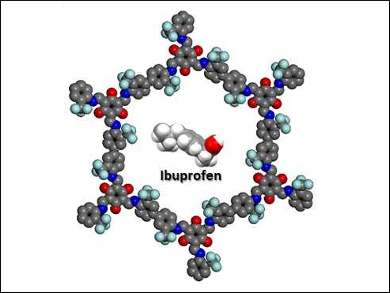Pharmaceuticals can end up as contaminants in the environment. The production and consumption of pharmaceuticals continue to increase, resulting in a need for new and efficient technologies for their capture and recovery, e.g., for water purification or analysis.
Begoña Espiña, Laura Salonen, International Iberian Nanotechnology Laboratory, Portugal, and colleagues have prepared a fluorine-bearing covalent organic framework (COF) that efficiently captures the drug ibuprofen from water at both neutral and acidic pH. The COF was formed from 3,3’‐bis(trifluoromethyl)benzidine and triformylphloroglucinol (structure section pictured). After the capture process, the ibuprofen could be recovered in high yield using isopropanol without damaging the porous material. This indicates that the COF can be efficiently recycled and reused.
Lipophilic pharmaceuticals, i.e., ibuprofen and diclofenac, were adsorbed much more efficiently than the hydrophilic ones acetaminophen and ampicillin. This indicates that hydrophobic interactions play a role in the drug adsorption. The results suggest that COF materials can be designed to selectively target a class of contaminants.
- Adsorption of Pharmaceutical Pollutants from Water Using Covalent Organic Frameworks,
Abdelkarim Mellah, Soraia P. S. Fernandes, Ramón Rodríguez, José Otero, Jairo Paz, Jacobo Cruces, Dana D. Medina, Harik Djamila, Begoña Espiña, Laura M. Salonen,
Chem. Eur. J. 2018, 24, 10601–10605.
https://doi.org/10.1002/chem.201801649




